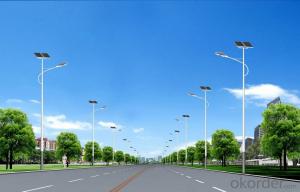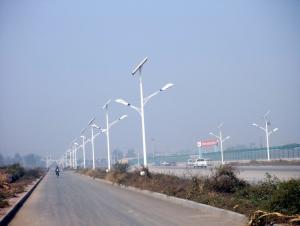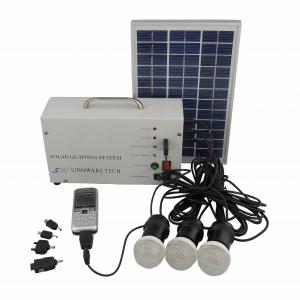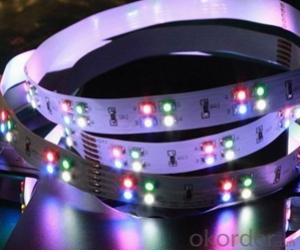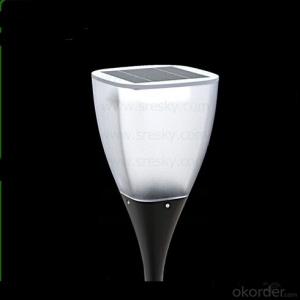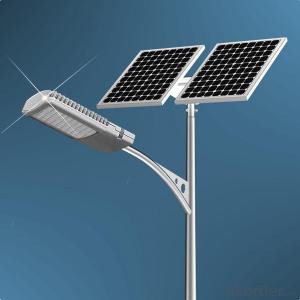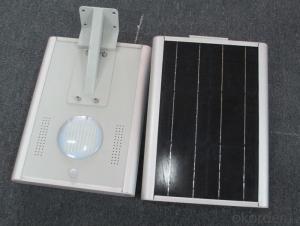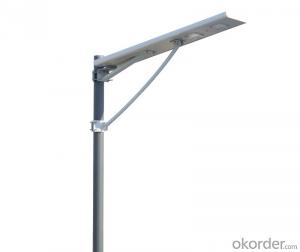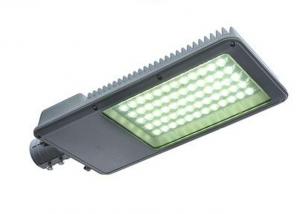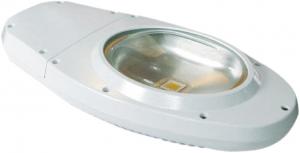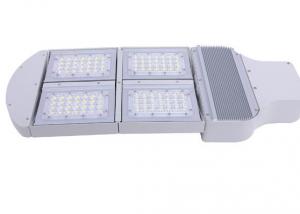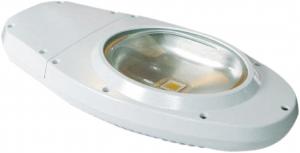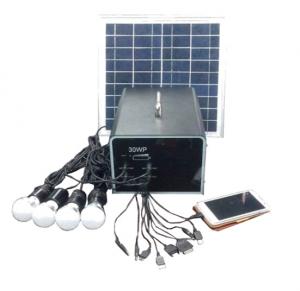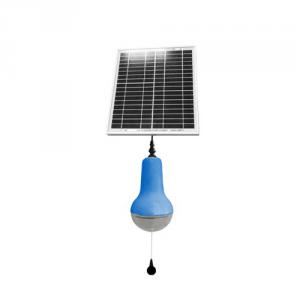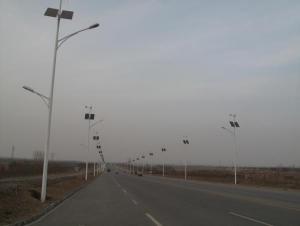Solar Light Solar Product Off Grid New Energy GW02
- Loading Port:
- Shanghai
- Payment Terms:
- TT OR LC
- Min Order Qty:
- 1 watt
- Supply Capability:
- 5000 watt/month
OKorder Service Pledge
OKorder Financial Service
You Might Also Like
1, Product desciption
Inverter circuits designed to produce a variable output voltage range are often used within motor speed controllers.
The DC power for the inverter section can be derived from a normal AC wall outlet or some other source. Control and feedback circuitry is used to adjust the final output of the inverter section which will ultimately determine the speed of the motor operating under its mechanical load.
Motor speed control needs are numerous and include things like: industrial motor driven equipment, electric vehicles, rail transport systems, and power tools. (See related: variable-frequency drive ) Switching states are developed for positive, negative and zero voltages as per the patterns given in the switching Table.
The generated gate pulses are given to each switch in accordance with the developed pattern and thus the output is obtained.
Solar power is energy from the sun. "Solar" is the Latin word for "sun" and
And Powerful source of energy. Without it, there will be no life.
Solar energy is considered as a serious source of energy for many years
of the vast amounts of energy that is made freely available, if harnessed by modern technology.
A magnifying glass can be used to heat up a small amount of water.
The short piece of copper tube is sealed at one end and filled with water.
And magnifying glass is then used to warm up the pipe.
Using more than one magnifying glass will increase the temperature more rapidly.
2, Features of the product
Inverters convert low frequency main AC power to higher frequency for use in induction heating.
To do this, AC power is first rectified to provide DC power. The inverter then changes the DC power to high frequency AC power. Due to the reduction in the number of DC Sources employed, the structure becomes more reliable and the output voltage has higher resolution due to an increase in the number of steps so that the reference sinusoidal voltage can be better achieved.
This configuration has recently become very popular in AC power supply and adjustable speed drive applications. This new inverter can avoid extra clamping diodes or voltage balancing capacitors. There are three kinds of level shifted modulation techniques, namely: 1,High and stable conversion efficienly based on over 4 years professional experience
2 ,High reliability with guaranteed +/-10% output power tolerance
3,Proven materials,tempered front glass,and a sturdy anodized aluminum frame allow modules to operate reliably in multiple mountily configurations
4,Combination of high efficicncy and attractive appearance
The first thing to figure out is the length of road in need of street lights.
This can be a small entrance road only a couple hundred of feet long to miles of streets through an area. Does the area currently have any type of lighting available.
What is the reason for needing street lights in this area
Is the electrical grid already nearby or would you need to call in the power company to bring in electrical lines.
If the electric needs to be brought to the area, how much is this going to cost? Depending on how far the grid electric is from the location of the needed lighting, this can be quite expensive.
How much lighting is needed on the street? Do the lights need to be dark sky compliant.
Do the street lights need to run from dusk to dawn or for only a specified number of hours at night.
Are the street lights able to dim in the middle of the night and still provide enough lighting.
These questions need to be answered before you can decide on how many lights you will need to complete the project.
3, Detailed Specification
Data Sheet of High Quality Solar Light
ModelTracer-1210RN
Rated system voltage12/24V auto work
Rated battery current10A
Rated load current10A
Max.battery voltage32V
Max.PV open circuit voltage100VDC
Max.PV input power12V 130W;24V 260W
Self-consumption<10ma(24v)< span="">
Charge Circuit Voltage<=0.26v< span="">
Discharge Circuit Voltage Drop<=0.15v< span="">
CommunicationTTL232/8 pin RJ45
Temp/compensation-30mV/℃/12V(25℃)
Working temperature-35℃~+55℃
Storage temperature range-35℃~+55℃
4, Product Image
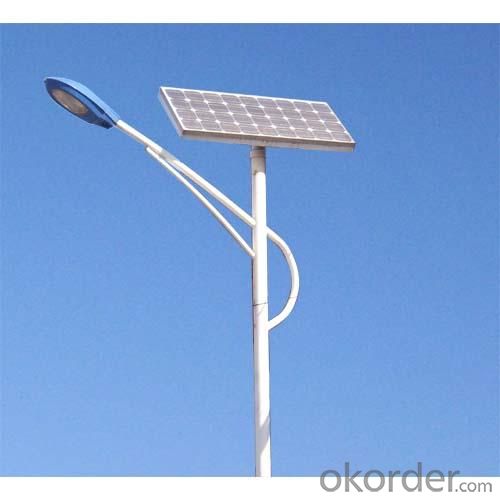
- Q:How do solar lights handle electromagnetic interference from vehicles?
- Solar lights are generally not affected by electromagnetic interference (EMI) from vehicles. This is because solar lights are designed to work independently of any external power source, including the electrical systems of vehicles. Solar lights use photovoltaic panels to convert sunlight into electricity, which is stored in batteries for later use. The internal circuitry of solar lights is specifically designed to filter out any EMI that may be present in the environment. This ensures that the solar light functions properly and is not affected by any interference caused by vehicles or other sources. Additionally, solar lights are typically installed in outdoor environments, away from the immediate vicinity of vehicles. This further reduces the chances of any EMI from vehicles affecting the performance of solar lights. In conclusion, solar lights are designed to handle electromagnetic interference from vehicles and other sources, ensuring that they continue to operate efficiently and provide reliable lighting.
- Q:Can solar lights be used for bus shelters or train stations?
- Yes, solar lights can be used for bus shelters or train stations. Solar lights are a sustainable and cost-effective solution for illuminating outdoor spaces, including bus shelters and train stations. They are easy to install, require minimal maintenance, and can operate independently from the electric grid, making them an ideal choice for these types of public transportation facilities.
- Q:Can solar lights be used in parking lots?
- Yes, solar lights can be used in parking lots. Solar lights are a viable and sustainable option for illuminating parking lots as they harness energy from the sun to power their operation. They are highly efficient, cost-effective, and environmentally friendly, making them a popular choice for outdoor lighting in parking lots.
- Q:Can solar lights be used for outdoor retail displays?
- Yes, solar lights can be used for outdoor retail displays. They are a sustainable and cost-effective option for illuminating products and creating an attractive visual display. Solar lights require no electricity or wiring, making them easy to install and move around as needed. They also contribute to a greener environment by reducing energy consumption.
- Q:Do solar lights have adjustable brightness based on ambient light conditions?
- Yes, many solar lights have adjustable brightness based on ambient light conditions. These lights are equipped with a light sensor that automatically detects the level of natural light available and adjusts the brightness accordingly. During the day, when there is ample sunlight, the solar lights will typically remain off or emit a low level of light. As the evening approaches and the ambient light decreases, the lights will automatically increase their brightness to provide adequate illumination. This feature helps conserve energy by ensuring that the lights only operate at their full brightness when needed. Additionally, some solar lights may also offer manual adjustment options, allowing users to customize the brightness settings to their preference.
- Q:Can solar lights be used near water bodies?
- Yes, solar lights can be used near water bodies. They are designed to be weather-resistant and can withstand exposure to water. However, it is important to ensure that the solar lights are properly installed and protected from direct contact with water to prevent any damage or malfunction.
- Q:What is the cost of installing solar lights?
- There are several factors that can influence the cost of solar light installation, including the type and quality of the lights, the area's size requiring illumination, and the complexity of the installation process. Typically, each light can cost anywhere between $100 and $1,500 on average. Nevertheless, it is crucial to take into account the long-term advantages of solar lights, as they utilize renewable energy and have minimal operational expenses. In the long run, solar lights can contribute to savings on electricity bills and a decrease in carbon emissions, thus making them a valuable investment.
- Q:Can solar lights be used for garden pond lighting?
- Yes, solar lights can be used for garden pond lighting. They are a popular and eco-friendly option for illuminating garden ponds as they do not require electricity and can be easily installed without the need for wiring. Solar lights harness energy from the sun during the day and automatically turn on at night, providing a beautiful and sustainable lighting solution for garden ponds.
- Q:Do solar lights have automatic brightness adjustment?
- Yes, solar lights can have automatic brightness adjustment. Many solar lights are equipped with sensors that detect the ambient light levels and adjust the brightness accordingly. This feature ensures efficient energy usage and allows the lights to automatically adapt to changing lighting conditions.
- Q:How do solar lights handle power fluctuations caused by nearby electrical equipment?
- Solar lights are designed to handle power fluctuations caused by nearby electrical equipment in a few different ways. Firstly, solar lights typically have built-in voltage regulation and control mechanisms that help stabilize the power supply and protect the light from sudden spikes or drops in voltage. These mechanisms ensure that the light operates within a safe and optimal voltage range. Additionally, solar lights often incorporate surge protection devices that act as safeguards against power fluctuations. These devices are designed to absorb and dissipate excess electrical energy, preventing it from damaging the light's internal components. Furthermore, solar lights may also have advanced circuitry that helps mitigate the impact of power fluctuations. This circuitry can detect voltage variations and adjust the light's power output accordingly, ensuring a consistent and reliable illumination even in the presence of electrical equipment nearby. Overall, solar lights are engineered to withstand power fluctuations caused by nearby electrical equipment. By incorporating voltage regulation mechanisms, surge protection devices, and advanced circuitry, these lights are able to maintain their performance and longevity even in less stable power environments.
1. Manufacturer Overview |
|
|---|---|
| Location | |
| Year Established | |
| Annual Output Value | |
| Main Markets | |
| Company Certifications | |
2. Manufacturer Certificates |
|
|---|---|
| a) Certification Name | |
| Range | |
| Reference | |
| Validity Period | |
3. Manufacturer Capability |
|
|---|---|
| a)Trade Capacity | |
| Nearest Port | |
| Export Percentage | |
| No.of Employees in Trade Department | |
| Language Spoken: | |
| b)Factory Information | |
| Factory Size: | |
| No. of Production Lines | |
| Contract Manufacturing | |
| Product Price Range | |
Send your message to us
Solar Light Solar Product Off Grid New Energy GW02
- Loading Port:
- Shanghai
- Payment Terms:
- TT OR LC
- Min Order Qty:
- 1 watt
- Supply Capability:
- 5000 watt/month
OKorder Service Pledge
OKorder Financial Service
Similar products
New products
Hot products
Hot Searches
Related keywords
